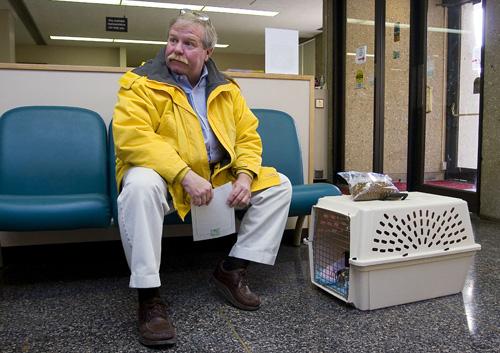Dogs, cats, even exotics find help at Vet-Med’s small animal clinic
Jan 27, 2009
Allyson Dunlap has experienced a pet owner’s worst nightmare: She accidentally ran over her beloved Dachshund, Bogie. Dunlap didn’t quite know what had happened, but she knew something was wrong and that she had to provide emergency care for her pet.
Dunlap lives in Champaign, and she made an immediate call to her local veterinarian as she rushed Bogie to help.
The vet she called said the clinic was closing at 5 p.m. – too soon to help Bogie.
She called a second clinic and received the same aloof response: The doors were closing at 5 p.m., but the emergency clinic would be open at 6 p.m. That vet told Dunlap she should call the University’s Veterinary Medical Emergency center, but the clinic did not have the number.
She was finally able to track down the number by calling information.
Get The Daily Illini in your inbox!
“Oh my gosh, everything was wonderful from the time I talked on the phone to the time I walked out the door,” Dunlap said.
“They were helping me on the phone, and were waiting to scoop my dog up out of the car as soon as I pulled up. I was extremely mean to one of the girls initially, and I apologized later. I was under a lot of stress.”
Sadly, Bogie passed away. Too much time had passed.
But even though Dunlap is still trying to cope with the accident and loss of her pet, she gives great credit to the staff that helped her at Vet-Med.
The University has a state-of-the-art veterinarian facility that serves the public 24 hours a day, seven days a week, and is open during all holidays.
Although most professionals are familiar with the University’s small animal clinic, the general public is largely unaware it exists. Just ask Dunlap.
“It’s one of Champaign’s best-kept secrets,” she said.
Dr. Mauria O’Brien, assistant professor at the Veterinary Teaching Hospital, is well aware of it.
“Since we’ve been here, Dr. McMichael and I have been trying to get the word out,” she said.
O’Brien and her colleagues have been trying to advertise themselves among the local veterinary clinics.
“We’re not trying to take anyone’s business away. In fact, we’re trying to be an avenue or resource for them,” O’Brien said.
The intensive care unit and emergency room at the veterinary hospital are top-notch.
Eric Heaton, of Big Rock, Ill. traveled three hours at the crack of dawn to take advantage of the clinic’s services.
“It’s one of the few places that can do heart tests. They can take care of dogs with complicated tests while they’re still awake without [sedating them],” he said.
Heaton brought his daughter’s Pomeranian in for physical therapy, but he regularly brings his six Golden Retrievers in for tests so they can take part in competitions.
University fourth-year veterinarian student Jeannie Harrison regularly takes shifts in the small animal emergency room, doing 12-hour stretches at a time while balancing her piles of homework.
She works under the close supervision of intern and resident doctors of veterinary medicine.
“It is really rewarding to see a critical patient arrive in the ER, then leave several days later happy and healthy again,” Harrison said.
Alyssa Galligan, head technician for the emergency room and intensive care unit, has put in 16 years of service.
One of her main concerns is keeping the public informed that the University is an additional option for their pets.
She noted that many people think the clinic is strictly a research facility.
“We have equipment that normal practitioners normally don’t possess,” she said.
“We also are a rare resource for exotics,” referring to animals that aren’t typically found in the area or kept as pets.
Fourth-year veterinary student Erin Rothrock has her eye on caring for exotics, and her expertise is one of the reasons the University clinic is versed in many areas of veterinary medicine.
“We have an exotic vet on call 24 hours a day. The school is a good place in town to care for exotics, but it isn’t the sole clinic,” Rothrock said.
Dunlap may have experienced a great loss with her beloved pet, but she now has a mission to ensure that the community knows they have a great resource at the University.
“When you have a pet, it’s one of your children. Everyone [at the University] was wonderful,” Dunlap said.






